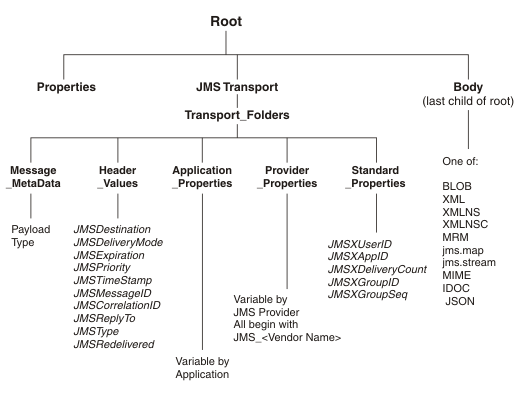The following figure depicts the JMS message tree that is propagated from the JMSInput node and can be propagated to the JMSOutput and JMSReply nodes. The JMSOutput and JMSReply nodes populate details of the JMS message that is sent to the LocalEnvironment WrittenDestination folder, as described in JMSOutput node.

JMSTransport
- Header_Values subfolder:
This subfolder is mandatory and is always created.
- Properties subfolders:
JMS message properties are optional; if they are present in the message, they are stored in the appropriate properties subfolder.
- Message_MetaData subfolder:This subfolder is included to preserve the payload type of the JMS message. The folder is used by the JMSOutput node when it creates a JMS message. The payload type can be one of the values shown in the following table.
Message type Payload values Base JMS message with no payload jms_none TextMessage jms_text BytesMessage jms_bytes MapMessage jms_map StreamMessage jms_stream ObjectMessage jms_object
Body
The message payload
is stored in the body folder, which is the last child of Root. The
payload is transferred by using one of the following message domain
parsers:
- XML
- XMLNS
- XMLNSC
- BLOB
- JMSMap
- JMSStream
- MRM
- MIME
- IDOC
- JSON
- DFDL
 Last updated Friday, 21 July 2017
Last updated Friday, 21 July 2017